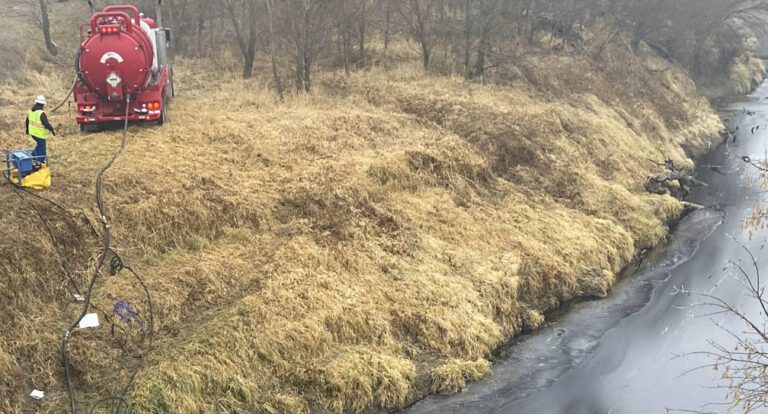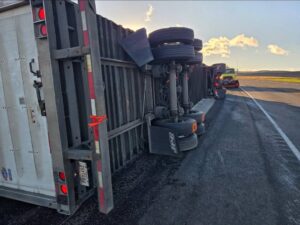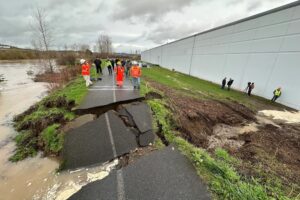TOPEKA, Kan. — The company operating a pipeline that spilled about 14,000 bathtubs’ worth of oil into a Kansas creek during a test for potential problems is recovering at least a small portion of the crude.
The U.S. Environmental Protection Agency said Tuesday that Canada-based TC Energy has recovered 2,598 barrels of oil mixed with water from the 14,000-barrel spill on a creek running through rural pastureland in Washington County, Kansas, about 150 miles northwest of Kansas City. Each barrel is enough to fill a household bathtub.
Last week’s rupture in Kansas forced the company to shut down the Keystone system, and it hasn’t said when it will come back online. The company said it is working around-the-clock to suck up spilled oil using big rigs equipped with what essentially are large wet vacuums.
No one was evacuated, and officials said no drinking water was affected. The company has promised to fully comply with demands from regulators and to work until it has “fully remediated the site.”
Concerns that spills could pollute waterways spurred opposition to plans by TC Energy to build another crude oil pipeline in the same system, the 1,200-mile (1,900-kilometer) Keystone XL, across Montana, South Dakota and Nebraska. President Joe Biden’s cancelation of a permit for the project led the company to pull the plug last year.
Last week’s spill was the largest on the Keystone system since it began operating in 2010 and the largest onshore spill since a Tesoro Corp. pipeline rupture in North Dakota leaked 20,600 barrels in September 2013, according to U.S. Department of Transportation data. The agency’s pipeline safety arm last week ordered TC Energy to take corrective action.
The order said TC Energy was running an in-line inspection using a device inside the pipeline that was some 80 miles (129 kilometers) past where the pipeline ruptured. Such devices are designed to fit tightly inside and are known as “pigs” because early wooden ones squeaked as they went through.
Three university petroleum engineering instructors who reviewed the regulators’ order ahead of Associated Press interviews pointed out the testing, which federal guidelines call for doing at least once every five years.
“That timing is definitely suspicious,” said Jennifer Miskimins, head of the Colorado School of Mines’ petroleum energy department. “It is like blowing a pea through a pod.”
She along with instructors from the University of Tulsa and Pennsylvania State University said moving a pig through the pipe would have required additional pressure. But Bill Caram, executive director of the advocacy Pipeline Safety Trust, saw the timing of the two events as “a weird coincidence.”
Local farmer Bill Pannbacker said the rupture occurred on his land at a point after the pipe goes under a creek and starts to ascend an 80-foot (24-meter) hill. Mike Stafford, the University of Tulsa instructor, said such a location is typical of where pipes tend to fail. That’s because oil contains a little water that tends to separate, and when oil is carried up hills that water flows back down, causing corrosion.
While Sanjay Srinivasan, the Penn State professor, was skeptical that corrosion was to blame because it is a slow process, he took note of the failure occurring in a section with a lot of bends.
“It’s not unusual for those kinds of locations to go through some severe stress that can cause these things,” he said. “If there is any weak spot, that’s when it’ll show up.”
TC Energy used booms, or barriers, to contain the oil in the creek and built two earthen dams to prevent it from moving into larger waterways.
The regulators’ order said TC Energy cannot restart operations for the 96-mile (155-kilometer) Keystone segment from Steele City, Nebraska, south to Hope, Kansas, without their permission. It also said the company must reduce the operating pressure by 20% inside that segment of the pipeline.
The company also must identify the cause of the spill and submit a plan for finding similar problems elsewhere and conducting additional tests by early March.
“They need to excavate the pipe in such a way that it’s preserved just for the investigation, for that root-cause analysis, and that takes probably the most time,” Caram said. “But the actual repair can be pretty quick.”
The Associated Press is an independent global news organization dedicated to factual reporting. Founded in 1846, AP today remains the most trusted source of fast, accurate, unbiased news in all formats and the essential provider of the technology and services vital to the news business. The Trucker Media Group is subscriber of The Associated Press has been granted the license to use this content on TheTrucker.com and The Trucker newspaper in accordance with its Content License Agreement with The Associated Press.















